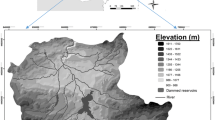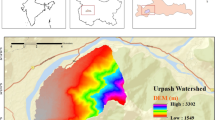Abstract
Soil erosion is one of the most prevailing forms of land degradation all over the world. The type and density of vegetation cover are effective on magnitude of soil erosion. The understanding of interactions between land use management, land cover, and topographical properties of landscape is important to effectively control soil erosion implementing best management practices. Regarding the influences of crop cover characteristics on soil erosion patterns; the presented study was conducted with the aim of evaluation of temporal soil erosion patterns affected by vegetation cover using revised universal soil loss equation (RUSLE) model. The study area is located in the border of Khuzestan and Chaharmahal Province, Iran, country with the geographical coordination of 31° 33′ 48′′ to 32° 25′ 40′′ N and 49° 50′ 44′′ to 50° 51′ 55′′ E. The input factors of RUSLE model including R, K, LS, and CP were generated using the Map algebra in ArcGIS 10.4 software. Afterwards, based on the real data, the 5 and 10 year forecasted of NDVI (normalized difference vegetation cover) was calculated and C-factor was estimated. Moreover, the spatial distribution of C-factor, canopy cover percentage (real and forecasted), Excess Greenness Index, Fractional Vegetation Index and NDVI* were mapped. Our results revealed that areas with the highest NDVI have the lowest C-factor with the lowest water erosion potential (R2 0.998). Also there was no remarkable difference between 5- and 10-year-forecasted C-factor in all studied stations because of no meaningful variations in the rainfall amount during this 5 years. Based on the Excess Greenness Index, the study area mostly is bared with a potential for soil erosion. The map of soil erosion distribution generated by RUSLE model depicted that the average amount of soil erosion was 13.68 tone/ha/year (STD 22.28), whereas for 10-year forecasted of soil erosion was 6.42 tone/ha/year (STD 9.80). Our mapping results illustrated that there was three main classes of soil erosion patterns including, the area with erosion mitigation, the area without change, and the area with increasing of soil erosion. These patterns confirmed that the vegetation cover distribution was different in the study area. Regarding the reduction of R-factor, the 10-year-forecasted soil erosion meaningfully decreased. Generally, the RUSLE model coupled with ArcGIS was capable to simulate soil erosion patterns and generate the spatial distribution map of erosion which is convenient visual tool to monitor and control of soil erosion. Furthermore, due to the variability of C-factor (temporal and spatial), therefore, more field experiments will be conducted for validating the C-factor forecasting using vegetation indices.









Similar content being viewed by others
References
Alewell C, Borrelli P, Meusburger K, Panagos P (2019) Using the USLE: chances, challenges and limitations of soil erosion modelling. Int Soil Water Conserv Res 7:203–225
Amsalu T, Mengaw A (2014) GIS based soil loss estimation using RUSLE model: the case of Jabi Tehinan Woreda, ANRS, Ethiopa. Nat Resour 5(11):616–626
Ashiagbor G, Forkuo EK, Laari P, Aabeyir R (2013) Modeling soil erosion using RUSLE and GIS tools. Int J Remote Sens Geosci (IJRSG) 2(4):7–17
Baiamonte G, Minacapilli M, Novara A, Gristina L (2019) Time scale effects and interactions of rainfall erosivity and cover management factors on Vineyard soil loss erosion in the Semi-Arid area of Southern Sicily. Water 11:978
Bashir S, Javed A, Bibi I (2018) Soil and water conservation. In: Sabir M, Akhtar J, Hakeem KR (eds) Soil science concepts and applications. University of Agriculture, Faisalabad
Benavidez R, Jackson B, Maxwell D, Norton K (2018) A review of the (Revised) Universal Soil Loss Equation ((R)USLE): with a view to increasing its global applicability and improving soil loss estimates. Hyrol Earth Syst Sci 22:6059–6086
Das B, Paul A, Bordoloi R, Prakash O, Pankaj T (2018) soil erosion risk assessment of hilly terrain through integrated approach of RUSLE and geospatial technology: a case study of Tirap District, Arunachal Pradesh. Model Earth Syst Environ 4(1):37–381
de Alejandro MA, Omasa K (2007) Estimation of vegetation parameter for modelling soil erosion using linear spectral mixture analysis of landsat ETM data. ISPRS J Photogramm Remote Sens 62:309–324
Dumas P, Printemps J (2010) Assessment of soil erosion using USLE model and GIS for integrated watershed and coastal zone management in the South pacific Islands. In: Proceedings, international symposium in Pacific Rim, pp 856–866
Gao YN, Gao JF, Wang J, Wang SS, Li Q, Zhai SH, Zhou Y (2017) Estimating the biomass of unevenly distributed aquatic vegetation in a lake using the normalized water-adjusted vegetation index and scale transformation method. Sci Total Environ 601:998–1007
Garcia Ruiz JM (2010) The effects of land uses on soil erosion in Spain: a review. CATENA 81:1–11
Hernando D, Romana MG (2015) Estimating the rainfall erosivity factor from monthly precipitation data in the Mardid Region (Spain). J Hydrol Hydromech 63(1):55–62
Jayasekara MJPTM, Kadupitiya HK, Vitharana UWA (2018) Mapping of soil erosion hazard zones of Sri Lanka. Trop Agric Res 29(2):135–146
Kamble B, Irmak A, Hubbard K (2013) Estimating crop coefficient using remote sensing-based vegetation index. Remote Sens 5:1588–1602
Karaburun A (2010) Estimation of C factor for soil erosion modeling using NDVI in Buyukcekmece watershed. Ocean J Appl Sci 3(1):77–85
Khademalrasoul A, Amerikhah H (2020) Study of soil erosion variations affected by climate changes using ARIMA-RUSLE model. Final report published in Shahid Chamran University research center
Kudnar NS (2020) GIS-based assessment of morphological and hydrological parameters of Wainganga River Basin, Central India. Model Earth Syst Environ 6:1933–1950
Kuo KT, Sekiyama A, Mihara M (2016) Determining C Factor of universal soil loss equation (USLE) based on remote sensing. IJERD Int J Environ Rural Development 2016:2–7
Li ZQ, Gao XL (2016) Remote sensing of terrestrial nonphotosynthetic vegetation using hyperspectral multispectral, SAR and LiDAR Data. Prog Phys Geogr Earth Environ 40(2):276–304. https://doi.org/10.1177/0309133315582005
Li F, Chen W, Zeng Y, Zhao QJ, Wu BF (2014a) Improving estimates of grassland fractional vegetation cover based on a pixel dichotomy model: a case study in Inner Mongolia, China. Remote Sens 6:4705–4722
Li HT, Zhao YJ, Li GR, Hu XS, Lu HJ, Zhu HL (2014b) Experimental research on slope protection with vegetation under situ rainfall simulation in cold and arid environment of loess area. Res Soil Water Conserv 6:304–311 (In Chinese)
Marc D, Richard H (2009) Reduction in agricultural non-point source pollution in the first year following establishment of an integrated grass/tree filter strip system in southern Quebec (Canada). Agric Ecosyst Environ 131:85–97
Modeste M, Abdellatif K, Nadia M, Zhang H (2016) Impact of land use and vegetation cover on risks of erosion in the Ourika watershed (Morocco). Am J Eng Res (AJER) 5:75–82
Nogueira SMC, Moreira MA, Volpato MML (2018) Relationship between coffee crop productivity and vegetation indexes derived from OLI/Landsat-8 sensor data with and without topographic correction. Eng Agric 38(3):387–394
Patil RJ, Sharma SK (2013) Remote sensing and GIS based modeling of crop/cover management factor (C) of USLE in Shakker river watershed. In: International conference on chemical, agricultural and medical sciences (CAMS-2013) Dec. 29–30, 2013 Kuala Lumpur (Malaysia). https://doi.org/10.15242/IICBE.C1213023
Quaye-Ballard JA, Okrah JM, Andam-Akorful SA, Awotwi A, Osei-Wusu AT, Tang X (2020) Assessment of vegetation dynamics in Upper East Region of Ghana based on wavelet multi-resolution analysis. Model Earth Syst Environ Model Earth Syst Environ 6:1783–1793
Renard KG, Freimund JR (1994) Using monthly precipitation data to estimate the R-factor in the revised USLE. J Hydrol 157(1–4):287–306
Renard KG, Foster GR, Weesies DK, Yoder DC (1997) Predicting soil loss by water: a guide to conservation planning with the Revised Soil Loss Equation (RUSLE), US Department of Agriculture, no. 2, pp. 11–23, Washington DC, USA
Scheftic W, Zeng X, Broxton P, Brunke M (2014) Intercomparison of seven NDVI products over the United States and Mexico. Remote Sens 6(2):1057–1084
Shahi E, Karimi S, Jafari HR (2020) Monitoring and modeling land use/cover changes in Arasbaran protected Area using and integrated Markov chain and artificial neural network. Model Earth Syst Environ 6:1901–1911
Small C (2003) High spatial resolution spectral mixture analysis of urban reflectance. Remote Sens Environ 88:170–186
Spalevi V, Nyssen J, Curovic M, Lenaerts T, Kerckhof A, Annys K, Van Den Branden J, Frankl A (2013) The impact of lan use on soil erosion in the river basin Boljanska Rijeka in Montenegro. In: IV International Symposium. 10.7251/AGSY1303054S
Talchabhadel R, Nakagava H, Kawaike K, Prajapati R (2020) Evaluating the rainfall erosivity (R-factor) from daily rainfall data: an application for assessing climate change impact on soil loss in Westrapti River basin, Nepal. Model Earth Syst Environ 6:1741–1762
Tanyas H, Kolat C, Lutfi Suzen M (2015) A new approach to estimate cover-management factor of RUSLE and validation of RUSLE model in the watershed of Kartalkaya Dam. J Hydrol 528:584–598
Tesfamichael SG (2004) Mapping potential soil erosion using RUSLE, remote sensing and GIS: the cas study of weenen game reserve, Kwazulu-Natal. M.Sc. thesis, School of Applied Environmental sciences Faculty of Science and Agriculture University of KwaZulu-Natal Pietermaritzburg, Pietermaritzburg, South Africa
Wang QJ, Zhao GX, Liu YL, Zhang PY, Cai J (2016) Effects of vegetation types on yield of surface runoff and sediment, loss of nitrogen and phosphorus along loess slope land. Trans Chin Soc Agric Eng 14:195–201 (In Chinese)
Wen J, Lai X, Pan XD, Pan XD (2013) Numerical simulation of fractional vegetation coverage influences on the convective environment over the source region of the Yellow River. Meteorol Atmos Phys 120:1–10
Zaimes GN, Kayiaoglu K, Kozanidis A (2017) Land use/vegetation cover and soil erosion impacts on soil properties of hilly slopes in Drama Prefecture of Northern Greece. Kastamonu Univ J For Fac 17(3):427–433
Zeng X, Dickinson RE, Walker A, Shaikh M, DeFries RS, Qi J (2000) Derivation and evaluation of globe 1-km fractional vegetation cover data for land modeling. J Appl Meteorol 39:826–839
Zhang S, Chen H, Fu Y, Niu H, Yang Y, Zhang B (2019) Fractional vegetation cover estimation of different vegetation types in the Qaidam Basin. Sustainability 11(864):1–17
Zhu G, Tang Z, Shangguan Z, Peng C, Deng L (2019) Factors affecting the spatial and temporal variations in soil erodibility of China. AGU 124(3):737–749
Funding
Funding was provided by Shahid Chamran University of Ahvaz, Iran. (GN:1314).
Author information
Authors and Affiliations
Corresponding author
Additional information
Publisher's Note
Springer Nature remains neutral with regard to jurisdictional claims in published maps and institutional affiliations.
Rights and permissions
About this article
Cite this article
Khademalrasoul, A., Amerikhah, H. Assessment of soil erosion patterns using RUSLE model and GIS tools (case study: the border of Khuzestan and Chaharmahal Province, Iran). Model. Earth Syst. Environ. 7, 885–895 (2021). https://doi.org/10.1007/s40808-020-00931-6
Received:
Accepted:
Published:
Issue Date:
DOI: https://doi.org/10.1007/s40808-020-00931-6




